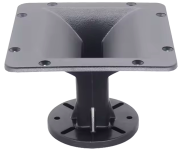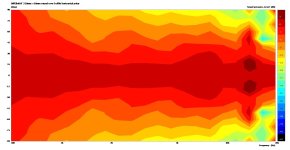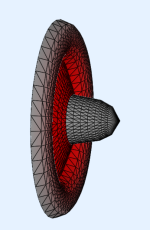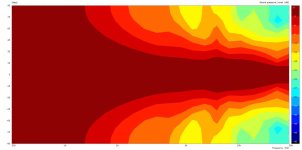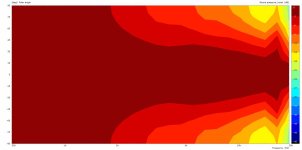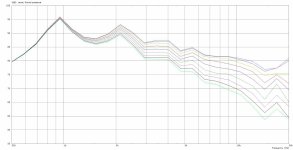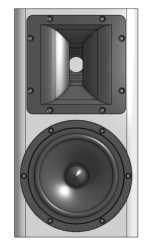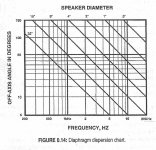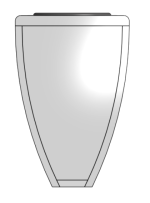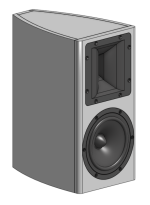After finishing my last speaker build i became interested in horn speakers. Especially the subject: horns/waveguides controlling early reflections in small rooms.
The Goal of the design is to provide good sound in a small room by lowering the amplitude of the early reflections, especially floor and ceiling reflections. Also, provide ample bass extension while limiting speaker size (Buchardt Audio S400).
The effect of early reflections is quite hard to deal with in small rooms, caused by the lack of flexibility in layout and space for room treatment.
I would love to hear your $0.02 on horn selection, LF driver selection etc. don't hold back!
March 14, 2025:
HF driver will be celestion cdx1-1747.
Currently working on the effect of the baffle on extending directivity to lower frequencies.
Evaluating directivity of RS180-8 on a baffle to match directivity with the HF driver.
Original text
For the HF i came up with the following combo:
Peerless XT25TG30-4 mounted on a no name constant directivity horn form Aliexpress. It measures 160mm x 160mm and has a depth of about 100mm.
After modeling the combo in AKABAK (without LEM, haven't figured it out) the following results are pretty good, IMO, for a 10 euro horn.
I already received the horns in the mail. Pretty thick material and a nice finish on the front. The flange to the driver is not that good. Its bumpy but fixable.
PS: the lines on the graphs are steps of 10 degrees. for the delay spectrum the color steps are in 5 dB.
Would this combo be any good and what would you use?
The Goal of the design is to provide good sound in a small room by lowering the amplitude of the early reflections, especially floor and ceiling reflections. Also, provide ample bass extension while limiting speaker size (Buchardt Audio S400).
The effect of early reflections is quite hard to deal with in small rooms, caused by the lack of flexibility in layout and space for room treatment.
I would love to hear your $0.02 on horn selection, LF driver selection etc. don't hold back!
March 14, 2025:
HF driver will be celestion cdx1-1747.
Currently working on the effect of the baffle on extending directivity to lower frequencies.
Evaluating directivity of RS180-8 on a baffle to match directivity with the HF driver.
Original text
Peerless XT25TG30-4 mounted on a no name constant directivity horn form Aliexpress. It measures 160mm x 160mm and has a depth of about 100mm.
After modeling the combo in AKABAK (without LEM, haven't figured it out) the following results are pretty good, IMO, for a 10 euro horn.
I already received the horns in the mail. Pretty thick material and a nice finish on the front. The flange to the driver is not that good. Its bumpy but fixable.
PS: the lines on the graphs are steps of 10 degrees. for the delay spectrum the color steps are in 5 dB.
Would this combo be any good and what would you use?
Attachments
Last edited:
I have a horn similar to that one, this is the AKABAK model result EbayDiffSlotHF . There are also some actual Measurements here, driven by a FaneCD130.
Did you model the Peerless dual ring radiator tweeter with this horn? Typically a tweeter waveguide (gradual, shallow walls) looks very different than a horn designed for a compression driver. IMO you should use a compression driver with this horn.
Did you model the Peerless dual ring radiator tweeter with this horn? Typically a tweeter waveguide (gradual, shallow walls) looks very different than a horn designed for a compression driver. IMO you should use a compression driver with this horn.
Yes, as shown in the first attached picture from the original post in red. I used the cone with center pole settings for it. So i simulated it as a flat cone driver with a center pole. The only thing i did not simulate are the T/S parameters. i used fixed driving. I haven't figured LEM out on AKABAK, yet.Did you model the Peerless dual ring radiator tweeter with this horn?
Thanks for posting! have been searching for info about this horn for some time.I have a horn similar to that one, this is the AKABAK model result EbayDiffSlotHF . There are also some actual Measurements here, driven by a FaneCD130.
Last edited:
No problem, you're welcome.
This is typically what you see when a tweeter has a waveguide PeerlessDRRwaveguide but there are lots of others TweeterWaveGuideList if you search the site. The Akabak model (post#1) shows only a single ring without phase plug. A compression driver presents a plane wavefront to the horn throat, so typically a fixed drive level disc membrane is used in Akabak to model the horn characteristics. The tweeter wavefront is different (more spherical) and so the waveguide is different.
This is typically what you see when a tweeter has a waveguide PeerlessDRRwaveguide but there are lots of others TweeterWaveGuideList if you search the site. The Akabak model (post#1) shows only a single ring without phase plug. A compression driver presents a plane wavefront to the horn throat, so typically a fixed drive level disc membrane is used in Akabak to model the horn characteristics. The tweeter wavefront is different (more spherical) and so the waveguide is different.
Would using a mesh file for the diaphragm and phase plug, model this more accurate?The tweeter wavefront is different (more spherical) and so the waveguide is different.
This thread was the inspiration for using a "normal" tweeter.
Since small rooms don't need the SPL of CD, i choose for a tweeter that could drive to 1-2k crossover which would be cheaper compared to CD with the same performance.
The Goal of the design is to provide good sound in a small room by lowering the amplitude of the early reflections. Also, provide ample bass extension while limiting speaker size. The effect of early reflections is quite hard to deal with in small rooms, caused by the lack of flexibility in layout and room for treatment.It would help if there was some design context on what you wanted to achieve with the speaker.
Thanks for the link. I would have liked to see the Polars and THD measurements to evaluate the designs. There is one more good thread that deals with tweeters on waveguides at OpenSourceTweeterWaveguides .
Certainly, making a more accurate model of the radiator diaphragm shape will give more accurate results. Yes, a mesh file would be one means to create it. You might also be able to create it using Akabak shells (torus, dome, disc, etc). Fixed level drive will allow you to evaluate the system's feasibility without considering the motor or diaphragm mechanical details.
Certainly, making a more accurate model of the radiator diaphragm shape will give more accurate results. Yes, a mesh file would be one means to create it. You might also be able to create it using Akabak shells (torus, dome, disc, etc). Fixed level drive will allow you to evaluate the system's feasibility without considering the motor or diaphragm mechanical details.
Constant directivety is not really possible with such a small horn. Well, it can be in the range of 2 ... 20 kHz, but what about the other half of the midrange frequencies?Peerless XT25TG30-4 mounted on a no name constant directivity horn form Aliexpress. It measures 160mm x 160mm [...]
True, the horn mouth size limits control down to ~1.5Khz - 2Khz depending on width required. The beam width should match either an 8" (low side) or 6.5" woofer (high side). It's not "constant", but it is controlled better than a bare tweeter.
Last edited:
@camplo , I like the Dayton H07E, its very smooth off axis from the built in roundovers. I have found that some drivers (like CDX-1446) does not seat properly and requires a gasket to avoid a gap that causes an HF notch. However, its not as wide or constant directivity at HF as the OP's horn.
I'll give it a try and include polars!Certainly, making a more accurate model of the radiator diaphragm shape will give more accurate results. Yes, a mesh file would be one means to create it. You might also be able to create it using Akabak shells (torus, dome, disc, etc). Fixed level drive will allow you to evaluate the system's feasibility without considering the motor or diaphragm mechanical details.
Good thinking. While looking at the mouth of the horn i simulated (HxW: 13cm x 11cm) and the maximum size of the speaker (HxWxD: 36cm x 20cm x 28cm) a larger CD horn could fit and extend the controlled directivity to lower frequencies.Constant directivety is not really possible with such a small horn. Well, it can be in the range of 2 ... 20 kHz, but what about the other half of the midrange frequencies?
Thanks for sharing! looks smooth, but having a more slim horizontal spread and less constant directivity probably gives a more restricted listening area. This could cause less flexibility in the layout of a small room.This one looks like a good one.
Beam width (directivity) is the tradeoff. If you want to reduce unwanted reflections, you need to reduce the beamwidth. A wider listening area requires wider beam width and more of that energy will reflect off other surfaces (walls). Acoustic treatment of the room helps alot, if that's an option.
true.Beam width (directivity) is the tradeoff. If you want to reduce unwanted reflections, you need to reduce the beamwidth. A wider listening area requires wider beam width and more of that energy will reflect off other surfaces (walls). Acoustic treatment of the room helps alot, if that's an option.
In summary: im looking for a horn that reduces energy in reflections compared to regular speakers and does not have a small and specific listening position.
Last edited:
That would be the middle road that most people have taken already. About 30+\- degrees is the middle road.In summary: im looking for a horn that reduces energy in reflections compared to regular speakers and does not have a small and specific listening position.
Here are the new results of the Aliexpress horn and the XT25TG30-4. I remodelled the driver to include the phase plug and include a ring radiator shape instead of a flat diaphragm. Also LEM is included.
PS: the polars are normalized.
PS: the polars are normalized.
Attachments
3D models are in progress. Still need to do the bracing, port or radiators, and some small details. Any suggestions on the overall design?
The woofer is a Dayton Audio RS180-8. Would love to know your opinion on the woofer selection.
Also, been thinking whether to choose between bass reflex or passive radiator. Are there audible differences?
The woofer is a Dayton Audio RS180-8. Would love to know your opinion on the woofer selection.
Also, been thinking whether to choose between bass reflex or passive radiator. Are there audible differences?
Attachments
Last edited:
There is a sound difference but I think its also a preference. The box can be designed for ported to get a lower F3 point. The port can also be plugged after to compare to what the sealed box sounds like. IMO sealed boxes sound more accurate and less thumpy but then it also has less bass. If there are no plans to use a subwoofer then I would port it. If this is an active speaker then sealed with bass boost is also an option depending on how loud you want.
I use similar drivers DSA175-8 and I like the neutral sound of metal drivers. The RS180-8 looks good as well and has a better cast frame. I thought Dayton drivers were more expensive in the EU? and that Peerless, Faital or SB were more common. I'm not advocating a preference, just options to consider.
I use similar drivers DSA175-8 and I like the neutral sound of metal drivers. The RS180-8 looks good as well and has a better cast frame. I thought Dayton drivers were more expensive in the EU? and that Peerless, Faital or SB were more common. I'm not advocating a preference, just options to consider.
Will go for the ported option then.
My reasoning for the RS180 compared to SB drivers:
The RS180-8, compared to SB 6 inch drivers like SB17NRX2C35-8, has lower f3 with a box volume of 11 L. When looking at the 5 inch versions of SB, 150 mm diameter, it looks a little silly with a 160mm horn.
The RS180-8 goes for 86 euro VS 76 for the SB17NRX2C35-8. So it's not that expensive.
My reasoning for the RS180 compared to SB drivers:
The RS180-8, compared to SB 6 inch drivers like SB17NRX2C35-8, has lower f3 with a box volume of 11 L. When looking at the 5 inch versions of SB, 150 mm diameter, it looks a little silly with a 160mm horn.
The RS180-8 goes for 86 euro VS 76 for the SB17NRX2C35-8. So it's not that expensive.
The larger RS180 is also a good match to the horn's beam width when crossed in the 1.5Khz-2Khz region.
You can simulate the woofer in Akabak using a pressure box linked to the LEM driver model. Its a short cut (instead of creating the drawing for the box) and allows you to combine the horn and woofer with XO components.
You can simulate the woofer in Akabak using a pressure box linked to the LEM driver model. Its a short cut (instead of creating the drawing for the box) and allows you to combine the horn and woofer with XO components.
Attachments
Nice! haven't thought of that.You can simulate the woofer in Akabak using a pressure box linked to the LEM driver model. Its a short cut (instead of creating the drawing for the box) and allows you to combine the horn and woofer with XO components.
Here is a different take on the design. More exciting build than just a rectangular box, but is bigger in total size for the same internal volume.
Attachments
- Home
- Loudspeakers
- Multi-Way
- bookshelf horn speaker for small room
